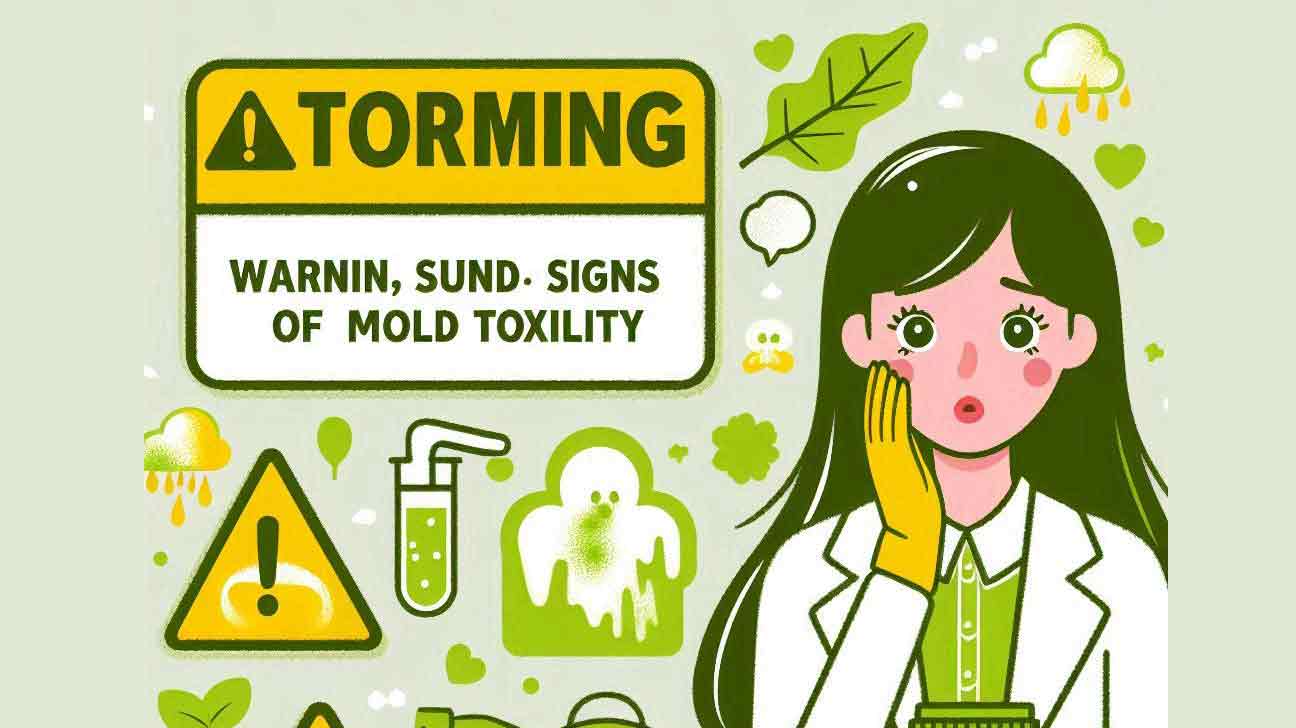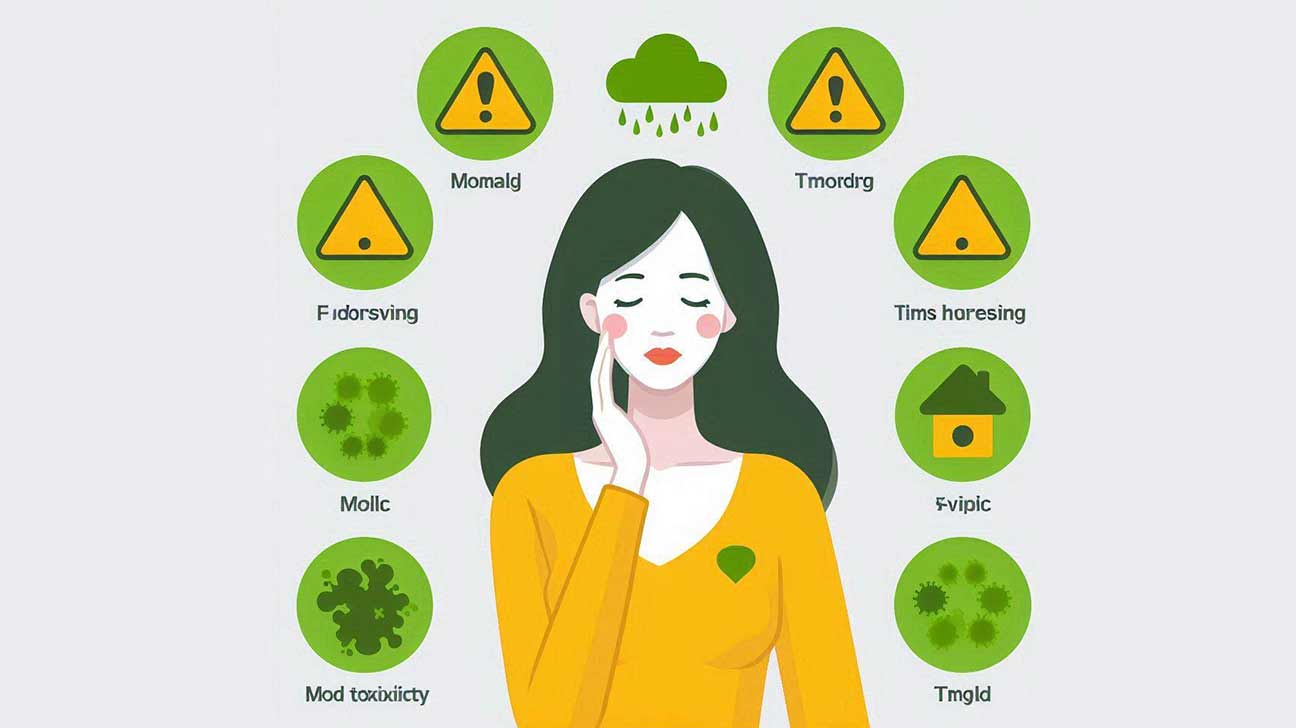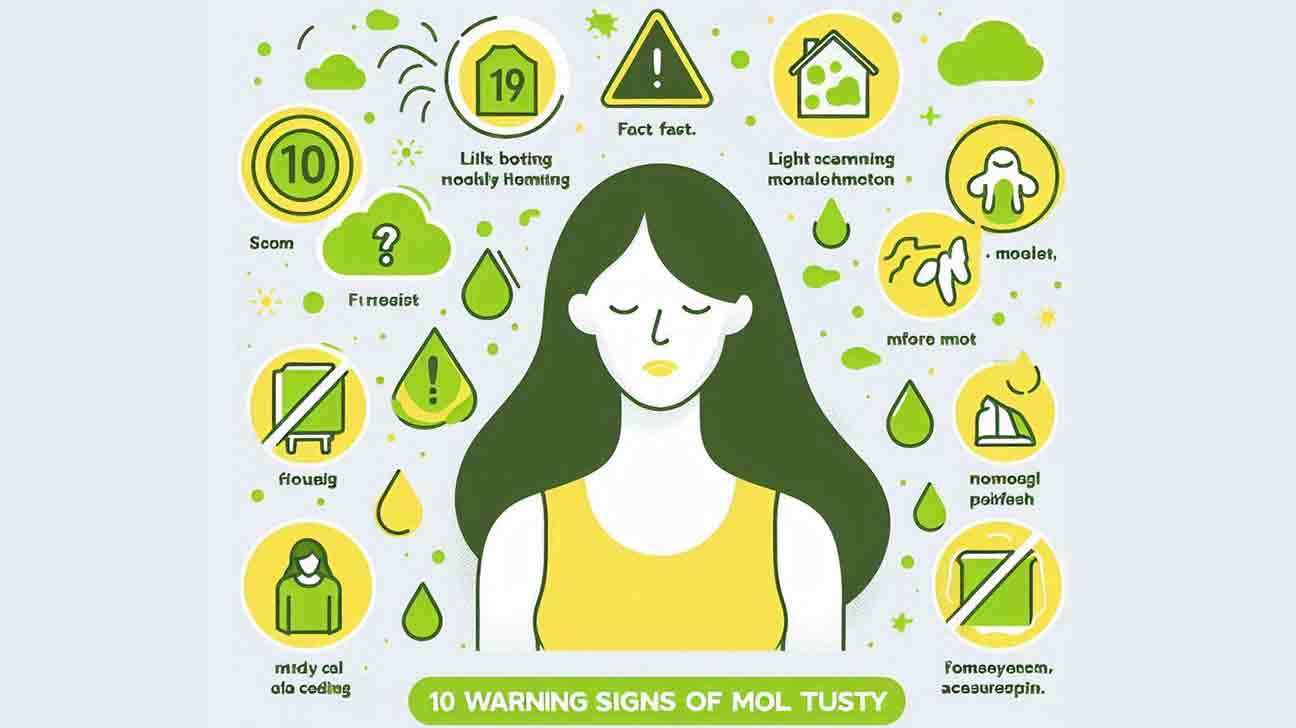
10 Warning Signs of Mold Toxicity
Mold toxicity can manifest through symptoms such as fatigue, headaches, and respiratory issues. If you notice a musty odor, visible mold, or recent water damage in your home, it could be a sign of mold toxicity.
These warning signs can indicate the presence of harmful mold spores, which can negatively impact your health. In this blog post, we will explore the top 10 warning signs of mold toxicity, helping you understand when to take action to protect yourself and your loved ones from potential health risks associated with mold exposure.
Mold Toxicity
Exposure to mold can lead to a range of health issues. Watch out for warning signs like allergies, fatigue, and respiratory problems. Other symptoms may include headaches, memory issues, and skin irritation. If you experience these, it’s best to address the mold problem promptly.
The Hidden Threat In Homes
Mold is a type of fungus that grows in damp and humid environments. It is a hidden threat that can be found in homes, offices, and other indoor spaces. Mold can grow on walls, ceilings, floors, carpets, furniture, and even in the air conditioning system. It can be difficult to detect because it often grows in hidden places and may not be visible to the naked eye. However, if left untreated, mold can cause serious health problems.
Health Risks Of Mold Exposure
Exposure to mold can cause a variety of health problems, especially in people with weakened immune systems or respiratory issues. Some of the most common health risks associated with mold exposure include:
- Allergic reactions
- Asthma attacks
- Respiratory infections
- Headaches
- Fatigue
- Dizziness
In more severe cases, mold exposure can lead to neurological problems and even death. Therefore, it is important to be aware of the warning signs of mold toxicity and take action if you suspect that you have been exposed to mold.
Identifying Mold In Your Environment
Mold can be a serious health hazard if not detected and addressed promptly. It’s important to be able to identify the presence of mold in your environment to protect yourself and your loved ones. In this section, we will discuss the common locations for mold growth and the visual signs that indicate its presence.
Common Locations For Mold Growth
Mold can thrive in various areas of your home or workplace. Being aware of these common locations can help you identify potential mold problems:
- In bathrooms: Mold tends to grow in damp and poorly ventilated areas, making bathrooms an ideal breeding ground. Pay close attention to areas around the shower, bathtub, sink, and toilet.
- In kitchens: Moisture from cooking and inadequate ventilation can lead to mold growth on walls, under sinks, and around appliances.
- In basements: Poor airflow, high humidity, and water seepage make basements susceptible to mold. Check for signs of mold on walls, floors, and any stored items.
- In attics: Leaks in the roof or inadequate insulation can create a humid environment, promoting mold growth in attics. Inspect the attic for any visible signs of mold.
- In crawl spaces: These areas often have poor ventilation and can accumulate moisture, providing an ideal habitat for mold. Regularly inspect crawl spaces for any signs of mold growth.
Visual Signs Of Mold Presence
Identifying mold visually is crucial for early detection. Look out for the following visual signs:
- Discoloration: Mold can appear in various colors, such as black, green, or white, and may resemble stains or patches on walls, ceilings, or other surfaces.
- Musty odor: Mold often produces a distinctive musty smell. If you notice an unpleasant odor in a particular area, it could indicate the presence of mold.
- Water stains: Water stains on walls or ceilings can be an indication of previous or ongoing water intrusion, which can lead to mold growth.
- Peeling or bubbling paint: Moisture from mold growth can cause paint to peel or bubble, particularly in areas where mold is present.
- Visible mold growth: In some cases, mold may be visible as fuzzy or powdery growth on surfaces, such as walls, floors, or furniture.
If you notice any of these warning signs, it’s important to take immediate action to address the mold issue. Ignoring mold growth can lead to health problems, including respiratory issues, allergies, and other adverse effects.
Respiratory Symptoms To Watch Out For
When dealing with mold toxicity, it’s crucial to pay attention to respiratory symptoms as they can indicate exposure to harmful mold spores. The following warning signs could point to potential mold-related health issues.
Chronic Coughing And Wheezing
Persistent coughing and wheezing that doesn’t seem to go away can be signs of mold toxicity affecting your respiratory system.
Difficulty Breathing
Struggling to breathe or experiencing shortness of breath could be a result of mold exposure causing inflammation in your airways.
Neurological Warning Signals
Experiencing neurological warning signals can be a sign of mold toxicity. These 10 warning signs include memory problems, headaches, dizziness, fatigue, and difficulty concentrating. It’s important to recognize these symptoms and take action to address mold exposure for a healthier living environment.
Neurological Warning Signals Mold toxicity can have a profound impact on our neurological health, leading to a range of symptoms that should not be ignored. It is important to recognize the warning signs associated with mold exposure, particularly when it comes to our brain and nervous system. In this section, we will discuss two common neurological warning signals: memory loss and confusion, as well as headaches and dizziness.
Memory Loss And Confusion
Experiencing memory loss and confusion can be alarming and disruptive to our daily lives. When exposed to mold toxins, these cognitive impairments can become more prevalent. You may find yourself struggling to remember simple things like where you placed your keys or forgetting important appointments. Additionally, you might experience difficulty concentrating and have trouble processing information. These symptoms can be especially concerning, as they can significantly impact our productivity and overall quality of life.
Headaches And Dizziness
Headaches and dizziness are common symptoms associated with mold toxicity. These neurological warning signals can range from mild to severe, and can occur frequently or sporadically. If you find yourself experiencing persistent headaches or bouts of dizziness without any apparent cause, it is essential to consider the possibility of mold exposure. These symptoms can be exacerbated in enclosed spaces or areas with high humidity levels, where mold tends to thrive. It is important to remember that these neurological warning signals should not be ignored. If you are experiencing memory loss, confusion, headaches, or dizziness, it is crucial to consult with a healthcare professional to determine the underlying cause. Identifying mold toxicity early on can help prevent further health complications and allow for appropriate treatment. Stay vigilant, and take proactive steps to create a mold-free environment for the sake of your neurological well-being.
Skin Reactions From Mold Exposure
Exposure to mold can lead to various skin reactions, which serve as warning signs of mold toxicity. These reactions may include redness, itchiness, rashes, and hives. It’s important to be aware of these symptoms and seek medical attention if you suspect mold exposure.
Mold exposure can cause a wide range of health problems, including skin reactions. Skin is the largest organ in our body, and it is the first point of contact with mold spores. Mold toxicity can cause a variety of skin reactions, including rashes, itching, hives, and dermatitis.
Rashes And Itching
Rashes and itching are some of the most common skin reactions caused by mold toxicity. Mold spores can irritate the skin and cause redness, itching, and rash. The rash may appear as small bumps or blisters, and it can be itchy and uncomfortable. Rashes caused by mold exposure can occur on any part of the body, but they are most common on the face, neck, arms, and legs.
Hives And Dermatitis
Hives and dermatitis are also common skin reactions caused by mold toxicity. THESE are itchy, raised, red welts that can appear on any part of the body. They can vary in size and shape and can be very uncomfortable. Dermatitis, on the other hand, is a general term used to describe any inflammation of the skin. It can be caused by a variety of factors, including mold exposure. Symptoms of dermatitis include redness, itching, and swelling of the skin. If you notice any of these skin reactions after being exposed to mold, it is important to seek medical attention. A healthcare professional can diagnose the cause of your skin reactions and provide appropriate treatment. In addition, it is important to take steps to prevent mold growth in your home or workplace to reduce your risk of mold toxicity.
Immune System Red Flags
When it comes to identifying the warning signs of mold toxicity, paying attention to immune system red flags is crucial. Mold exposure can have a significant impact on the immune system, leading to a range of symptoms that serve as indicators of potential mold toxicity.
Frequent Infections
The presence of mold toxins can weaken the immune system, making individuals more susceptible to frequent infections. Persistent colds and respiratory illnesses may signal an underlying issue related to mold toxicity.
Increased Allergies
Mold toxicity can lead to an increase in allergic reactions. Individuals may experience worsening hay fever or asthma symptoms, indicating a potential immune system response to mold exposure.
Digestive Issues Linked To Mold
Digestive issues such as bloating, constipation, and diarrhea can be warning signs of mold toxicity. Mold can release mycotoxins which may cause inflammation and irritation in the gut leading to various digestive problems. If you experience these symptoms, it’s important to have your home checked for mold and seek medical advice.
Nausea And Vomiting
Mold toxicity can trigger nausea and vomiting due to exposure.
Loss Of Appetite And Weight Loss
Loss of appetite and weight loss are common symptoms of mold toxicity.
Emotional And Mental Health Effects
Exposure to mold can have detrimental effects on emotional and mental health. Recognizing the 10 warning signs of mold toxicity, such as fatigue, anxiety, and difficulty concentrating, is crucial for early detection and seeking proper treatment. Protecting your well-being from mold-related issues is essential for maintaining overall mental and emotional wellness.
Anxiety And Depression
Mold toxicity can exacerbate existing anxiety and depression symptoms.
It may lead to feelings of hopelessness and persistent sadness.
Mood Swings
Mold exposure can result in sudden and unexplained mood swings.
Individuals may experience irritability and emotional instability.
Ocular Symptoms From Mold Toxicity
Experiencing ocular symptoms like redness, itching, and blurry vision can be warning signs of mold toxicity. These symptoms may indicate exposure to toxic mold spores, highlighting the importance of addressing mold issues promptly to safeguard your health.
Red And Watery Eyes
Mold toxicity can lead to red and watery eyes, causing discomfort and irritation.
Blurred Vision
Mold exposure may result in blurred vision, affecting your ability to see clearly.
Ocular Symptoms from Mold Toxicity:
Exposure to mold can trigger a range of symptoms affecting the eyes. These symptoms can manifest as red and watery eyes, as well as blurred vision. Mold toxicity can lead to discomfort and vision issues, impacting daily activities.
Fatigue And Weakness
If you are experiencing persistent tiredness and muscle weakness, it could be a sign of mold toxicity.
Persistent Tiredness
Constant fatigue can indicate mold exposure affecting your health.
Muscle Weakness And Aches
Weakness and aches in muscles may be linked to mold toxicity.
Ensuring Indoor Air Quality
Ensuring Indoor Air Quality is crucial for maintaining a healthy living environment. Mold toxicity can significantly impact air quality, leading to various health issues. By being aware of the warning signs of mold toxicity and taking proactive measures, you can safeguard your indoor air quality and well-being.
Ventilation And Humidity Control
Proper ventilation is key to preventing mold growth. Ensure adequate airflow throughout your home by utilizing exhaust fans, opening windows, and installing air vents. Additionally, maintaining optimal humidity levels (between 30-50%) inhibits mold proliferation. Use dehumidifiers in damp areas and address any plumbing leaks promptly to mitigate moisture buildup.
Air Purifiers And Filters
Investing in high-quality air purifiers and filters can significantly enhance indoor air quality. Look for HEPA (High Efficiency Particulate Air) filters, which effectively capture mold spores and other airborne contaminants. Regularly replace filters according to manufacturer recommendations to ensure optimal performance. This simple step can markedly reduce mold-related health risks.
Mold Inspection And Testing
Experiencing symptoms like allergies, fatigue, or respiratory issues? These could be warning signs of mold toxicity. Get a mold inspection and testing done to ensure a safe and healthy environment for you and your family. Don’t ignore the potential risks of mold exposure.
Mold is everywhere, and it’s hard to avoid. However, when mold starts to grow inside your home, it can become a serious problem. Not only can it damage your property, but it can also cause health problems for you and your family. If you suspect that you have mold in your home, it’s important to get it inspected and tested right away. In this section, we’ll discuss the different types of mold inspections and testing methods available.
Professional Mold Assessment
One of the best ways to determine if you have a mold problem is to hire a professional mold inspector. These professionals are trained to identify mold and determine the extent of the problem. They use specialized equipment to take air and surface samples, which are then sent to a lab for analysis. Once the results are in, the inspector will provide you with a detailed report that outlines the type of mold present, the severity of the problem, and recommendations for remediation.
Diy Mold Testing Kits
If you’re on a budget, you can also purchase DIY mold testing kits. These kits are available at most hardware stores and are relatively inexpensive. They typically include a petri dish and a swab, which you can use to collect a sample of the mold. You then send the sample to a lab for analysis. While these kits can be useful, they’re not always accurate. If you’re unsure about the results, it’s best to hire a professional mold inspector. Mold can be a serious problem, and it’s important to get it inspected and tested right away. Whether you hire a professional mold inspector or use a DIY mold testing kit, it’s important to take action if you suspect that you have a mold problem. By identifying the problem early on, you can prevent further damage to your property and protect the health of your family.
Cleaning And Mold Remediation
Mold can be a serious health hazard, causing various symptoms such as respiratory issues, allergies, and even neurological problems. It’s important to address mold growth promptly and effectively to ensure a safe and healthy living environment. In this section, we will discuss safe cleaning practices and when it’s necessary to call professionals for mold remediation.
Safe Cleaning Practices
When dealing with mold, it’s crucial to follow safe cleaning practices to minimize exposure and prevent further contamination. Here are some guidelines to keep in mind:
- Avoid direct contact with mold-affected areas without proper protective gear such as gloves, goggles, and a mask.
- Ensure proper ventilation by opening windows and using fans to circulate air during the cleaning process.
- Use a mixture of detergent and water to scrub the mold-infested surfaces.
- Thoroughly dry the cleaned areas to prevent moisture accumulation, which can contribute to mold growth.
- Regularly clean and maintain the HVAC system to prevent mold spores from spreading throughout the house.
When To Call The Professionals
While some minor mold issues can be tackled with DIY methods, there are situations where professional help becomes necessary. Here are some signs that indicate the need for mold remediation experts:
- If the affected area is larger than 10 square feet, it’s best to seek professional assistance.
- If there is visible mold growth in hidden or hard-to-reach areas such as behind walls or under flooring.
- If you or your family members are experiencing severe allergic reactions or respiratory symptoms that worsen when in the affected area.
- If you suspect that the mold is caused by a more significant issue, such as water damage or a leaking pipe.
- If you have attempted DIY mold removal but the problem persists or keeps recurring.
Remember, mold toxicity can have serious health implications, so it’s essential to address the issue promptly and effectively. By following safe cleaning practices and knowing when to call professionals, you can ensure a mold-free and healthy living environment for you and your loved ones.
Preventing Mold Growth
Mold toxicity can have serious health effects, making it crucial to prevent mold growth in your living spaces.
Moisture Control Strategies
- Keep indoor humidity below 60%.
- Fix leaks promptly to prevent water accumulation.
- Use exhaust fans in bathrooms and kitchens.
Regular Maintenance And Inspections
- Inspect pipes and roofs for leaks regularly.
- Ensure proper ventilation in attics and crawl spaces.
- Monitor basements for moisture and dampness.

Medical Attention For Mold Exposure
Experiencing symptoms like fatigue, headaches, and skin irritation could be warning signs of mold toxicity. Seeking medical attention for mold exposure is crucial to prevent long-term health effects such as respiratory issues, neurological problems, and immune system disorders.
Medical Attention for Mold Exposure When it comes to mold exposure, it’s important to be aware of the warning signs of mold toxicity. While some cases can be mild and easily remedied, others may require medical attention. In this section, we will discuss when to see a doctor and the available treatment options for mold exposure.
When To See A Doctor
If you experience any of the following symptoms after being exposed to mold, it is recommended to seek medical attention: 1. Persistent coughing or wheezing 2. Shortness of breath or difficulty breathing 3. Nasal congestion or sinusitis 4. Skin rashes or hives 5. Fatigue or weakness 6. Headaches 7. Irritated or watery eyes 8. Sore throat or hoarseness 9. Digestive issues, such as nausea, diarrhea, or abdominal pain 10. Neurological symptoms, including memory problems, difficulty concentrating, or mood changes. It’s important to note that these symptoms may vary from person to person and can range in severity. If you are unsure whether your symptoms are related to mold exposure, it is always best to consult with a healthcare professional.
Treatment Options
When it comes to treating mold exposure, there are several options available. The appropriate treatment will depend on the severity of the symptoms and the individual’s overall health. Here are some common treatment options:
1. Avoidance: The first step in treating mold exposure is to remove yourself from the environment where mold is present. This may involve leaving the affected area or even relocating if necessary.
2. Medications: Depending on the symptoms experienced, your doctor may prescribe medications to alleviate specific issues. This could include antihistamines for allergic reactions, nasal sprays for congestion, or inhalers for respiratory symptoms.
3. Immunotherapy: In cases of severe mold allergies, immunotherapy may be recommended. This involves receiving regular injections of small amounts of allergens to desensitize the immune system over time.
4. Symptom management: Your doctor may recommend over-the-counter medications or natural remedies to help manage symptoms such as headaches, coughing, or skin irritation.
5. Addressing underlying conditions: Mold exposure can exacerbate existing respiratory conditions such as asthma or allergies. In these cases, your doctor may focus on managing and treating these underlying conditions to minimize the impact of mold exposure.
Remember, it is crucial to consult with a healthcare professional for an accurate diagnosis and appropriate treatment plan. Mold toxicity can have serious health implications, and seeking medical attention is essential for your well-being.
Legal Aspects Of Mold Infestation
Mold toxicity can lead to legal issues, with 10 warning signs indicating its presence. These signs include musty odors, water damage, and respiratory problems, highlighting the need for prompt action to address mold infestation. Seeking legal advice is crucial to navigate the complexities of mold-related disputes.
Mold infestation is a serious issue that can lead to severe health problems. It is the responsibility of landlords to ensure that their properties are free from mold and tenants have the right to live in a safe environment. Mold toxicity can be a legal matter, and it’s essential to understand the legal aspects of mold infestation. In this section, we will discuss Tenant Rights and Landlord Responsibilities and Legal Recourse.
Tenant Rights And Landlord Responsibilities
Tenants have the right to live in a mold-free environment, and it’s the landlord’s responsibility to ensure that the property is safe for occupancy. Landlords are required to maintain their properties and promptly address any mold issues. In case of mold infestation, tenants should notify their landlords immediately, and landlords should take steps to remediate the issue as soon as possible. Failure to do so can result in legal action against the landlord.
Legal Recourse
If a landlord fails to address mold infestation, tenants have the legal right to take action. This can include filing a complaint with local housing authorities or taking legal action against the landlord. In some cases, tenants may also be entitled to compensation for any damages or health issues caused by mold toxicity. It’s essential to document all instances of mold infestation, including any communication with the landlord, to support any legal action. In conclusion, understanding the legal aspects of mold infestation is crucial for both tenants and landlords. Tenants have the right to live in a safe environment, and landlords have a responsibility to maintain their properties. If you’re experiencing mold toxicity, it’s essential to take action promptly and document all instances to support any legal action.
Impact On Property Value
Mold toxicity in a property can have a significant impact on its value. Potential buyers are wary of the health risks associated with mold exposure, leading to decreased interest and lower offers. Additionally, lenders may be hesitant to finance a property with a history of mold issues, further impacting its market value.
Disclosure And Remediation
When selling a property, it’s essential to disclose any known mold problems to potential buyers. Failure to do so can result in legal repercussions and worsen the property’s marketability. Additionally, proactive mold remediation can help maintain or restore a property’s value by addressing the issue and providing peace of mind to buyers.
Personal Stories Of Mold Toxicity
Uncover the 10 Warning Signs of Mold Toxicity through Personal Stories. Learn about real-life experiences revealing the subtle yet impactful indicators of mold-related health issues. Gain insights into the hidden dangers that mold toxicity can present in everyday environments.
Survivors’ Experiences
Mold toxicity can have a profound impact on individuals’ lives, and hearing personal stories can shed light on the severity and complexity of this condition. Survivors’ experiences highlight the warning signs and symptoms, as well as the challenges they faced in their journey towards recovery.
One survivor, Sarah, noticed persistent fatigue and headaches that seemed to worsen whenever she was at home. It wasn’t until she discovered mold growth behind her bathroom wall that she realized the cause of her health issues. Sarah’s story emphasizes the importance of being aware of any unusual symptoms and investigating potential sources of mold in your living environment.
Another survivor, Mark, experienced respiratory problems and unexplained allergic reactions for years. Doctors struggled to pinpoint the cause until he underwent extensive testing that revealed mold toxicity. Mark’s story reminds us that mold-related symptoms can often be misdiagnosed, highlighting the need for proper medical evaluation and awareness of mold as a potential culprit.
Many survivors faced significant challenges during their recovery journey. They encountered difficulties finding healthcare professionals knowledgeable about mold toxicity, leading to delays in diagnosis and treatment. Additionally, some struggled to find mold-free living environments, as mold can be pervasive and difficult to eradicate completely.
Recovery And Life After Mold
Despite the hardships, survivors of mold toxicity have found hope and regained their health through diligent efforts and support. Recovery often involves a multi-faceted approach, including detoxification, immune system support, and creating a mold-free living space.
For some, recovery meant making significant lifestyle changes, such as moving to a different home or implementing strict mold prevention measures. These survivors emphasize the importance of taking proactive steps to minimize exposure and maintain a healthy living environment.
Life after mold toxicity is a journey of resilience and renewed appreciation for health. Survivors often experience a newfound sense of gratitude for their well-being and a desire to raise awareness about mold toxicity’s impact on human health.
Sharing personal stories of mold toxicity not only raises awareness but also offers support and encouragement to those currently struggling with similar challenges. These stories serve as a reminder that recovery is possible, and that seeking professional help and making necessary changes can lead to a healthier and mold-free life.

Resources For Mold Toxicity Information
When dealing with mold toxicity, it’s crucial to have access to reliable resources for information, support, and education. Here are some valuable resources for mold toxicity information that can provide guidance and assistance to individuals dealing with this issue.
Support Groups And Forums
Connecting with others who have experienced mold toxicity can be incredibly beneficial. Participating in support groups and forums allows individuals to share experiences, gain insights, and access valuable resources. These platforms provide a sense of community and understanding that can be instrumental in navigating the challenges of mold toxicity.
Educational Materials
Access to educational materials is essential for understanding mold toxicity and its impact on health. Educational resources offer valuable information on identifying, addressing, and mitigating mold-related issues. They provide practical tips, expert insights, and up-to-date research to empower individuals with the knowledge needed to effectively manage mold toxicity concerns.
Frequently Asked Questions
What Are The Common Warning Signs Of Mold Toxicity?
Common warning signs of mold toxicity include respiratory issues, fatigue, headaches, and skin irritation.
How Can Mold Toxicity Affect Your Respiratory System?
Mold toxicity can lead to coughing, wheezing, throat irritation, and exacerbate asthma symptoms.
Can Mold Toxicity Cause Skin Problems?
Yes, mold toxicity can lead to skin rashes, irritation, itching, and other dermatological issues.
What Are The Potential Effects Of Mold Toxicity On Mental Health?
Mold toxicity can contribute to mood swings, anxiety, depression, and cognitive difficulties.
Is There A Connection Between Mold Toxicity And Fatigue?
Yes, mold toxicity can cause unexplained fatigue, weakness, and a general lack of energy.
Can Mold Toxicity Lead To Digestive Problems?
Mold toxicity can result in digestive issues such as nausea, vomiting, and abdominal pain.
How Does Mold Toxicity Impact Overall Well-being?
Mold toxicity can have a pervasive impact on overall health, affecting energy levels, mood, and physical comfort.
What Are The Potential Long-term Effects Of Mold Toxicity?
Long-term exposure to mold toxicity can lead to chronic respiratory conditions and ongoing health challenges.
Can Mold Toxicity Worsen Existing Health Conditions?
Yes, mold toxicity can exacerbate pre-existing respiratory issues, allergies, and skin conditions.
How Can Individuals Mitigate The Risks Of Mold Toxicity?
Preventive measures include addressing water leaks, improving ventilation, and promptly addressing any visible mold growth.

Conclusion
Recognizing the warning signs of mold toxicity is crucial for maintaining a healthy living environment. By being aware of symptoms such as persistent coughing, headaches, and fatigue, individuals can take prompt action to address the issue. Regularly inspecting and cleaning areas prone to mold growth, improving ventilation, and seeking professional help when needed can all contribute to preventing mold-related health problems.
Remember, staying proactive and informed is key to safeguarding your well-being.



